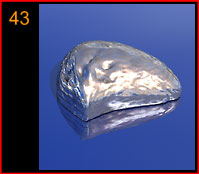
 |
|||||
 |
Technetium - Tc General Information Discovery Technetium was discovered by C. Perrier and E.G. Segre in 1937 in Palermo, Italy. It was the first element to be produced artificially. Appearance Technetium is a silvery-grey metal that tarnishes slowly in moist air. It is usually obtained as a grey powder. Source The metal is produced in tonne quantities from the fission products of uranium nuclear fuel. Uses Technetium is a remarkable corrosion inhibitor for steel, and can protect steel by the addition of very small amounts. This use is limited to closed systems as technetium is radioactive. Biological Role Technetium has no known biological role. It is a radioactive element. General Information Technetium is an excellent superconductor at 11 K and below. It resists oxidation, burns in oxygen and dissolves in nitric and sulphuric acids. |
| Physical Information | |||
| Atomic Number | 43 | ||
| Relative Atomic Mass (12C=12.000) | 98.91 | ||
| Melting Point/K | 2445 | ||
| Boiling Point/K | 5150 | ||
| Density/kg m-3 | 11500 (293K) | ||
| Ground State Electron Configuration | [Kr]4d55s2 | ||
| Electron Affinity(M-M-)/kJ mol-1 | 96 |
| Key Isotopes | ||||||
| nuclide | 97Tc | 98Tc | 99Tc | |||
| atomic mass | 97.911 | 98.90 | ||||
| natural abundance | 0% | 0% | 0% | |||
| half-life | 2.6x106 yrs | 1.5x106 yrs | 2.12x105 yrs |
| Other Information | ||
| Enthalpy of Fusion/kJ mol-1 | 23.81 | |
| Enthalpy of Vaporisation/kJ mol-1 | 585.22 | |
| Oxidation States | ||
| main | TcIV, TcV, TcVII | |
| others | Tc-I, TcO, TcVI | |
| Covalent Bonds /kJ mol-1 | ||
| not applicable | ||
| Ionisation Energies/kJ mol-1 | ||
| M - M+ | 702 | |
| M+ - M2+ | 1472 | |
| M2+ - M3+ | 2850 | |
| M3+ - M4+ | 4100 | |
| M4+ - M5+ | 5700 | |
| M5+ - M6+ | 7300 | |
| M6+ - M7+ | 9100 | |
| M7+ - M8+ | 15600 | |
| M8+ - M9+ | 17800 | |
| M9+ - M10+ | 19900 | |